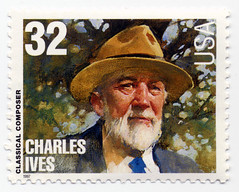And of course, here it is the Unaswered Question’s counterpart.
Ives wrote detailed notes concerning the purpose and context of Central Park in the Dark:
This piece purports to be a picture-in-sounds of the sounds of nature and of happenings that men would hear some thirty or so years ago (before the combustion engine and radio monopolized the earth and air), when sitting on a bench in Central Park on a hot summer night.
The piece is scored for piccolo, flute, E-flat clarinet, bassoon, trumpet, trombone, percussion, two pianos and strings. Ives specifically suggests the two pianos be a player-piano and a grand piano. The orchestral group are to be separated spatially from each other. Ives described the role of the instruments in a programmatic description of the piece:
The strings represent the night sounds and silent darkness- interrupted by sounds from the Casino over the pond- of street singers coming up from the Circle singing, in spots, the tunes of those days- of some ‘night owls’ from Healy’s whistling the latest of the Freshman March- the “occasional elevated,” a street parade, or a “break-down” in the distance- of newsboys crying “uxtries”- of pianolas having a ragtime war in the apartment house “over the garden wall,” a street car and a street band join in the chorus- a fire engine, a cab horse runs away, lands “over the fence and out,” the wayfarers shout- again the darkness is heard- an echo over the pond- and we walk home.
Central Park in the Dark displays several characteristics that are typical of Ives’s work. Ives layers of orchestral textures on top of each other to create a polytonal atmosphere. Within this polytonal atmosphere, Ives juxtaposes the different sections of the orchestras in contrasting and clashing pairings (i.e. the ambient, static strings against the syncopated ragtime pianos against a brass street band). These juxtapositions are a prevalent them in the works of Ives and can be seen most notably in The Unanswered Question, Three Places in New England, and Symphony No. 4.

 Dai
Dai